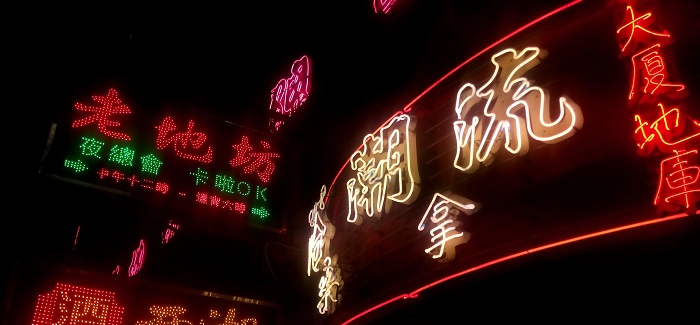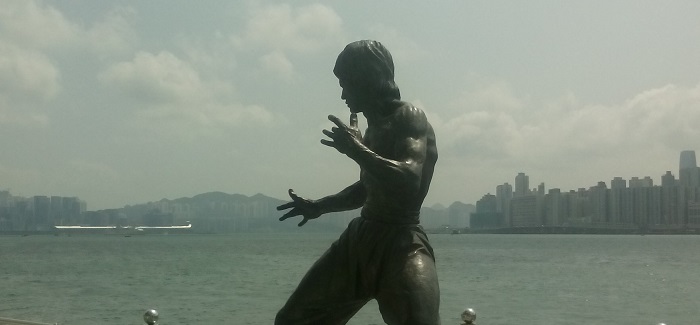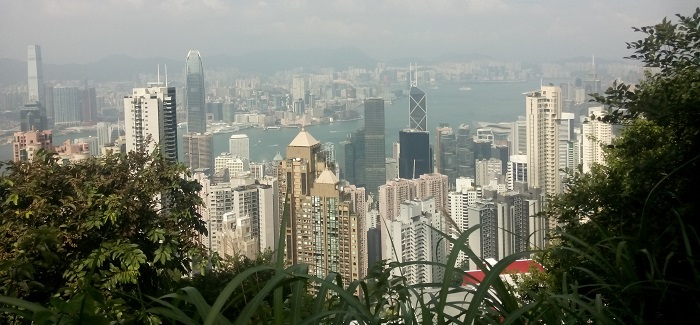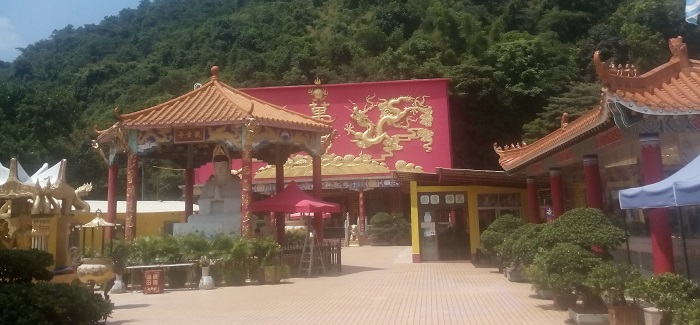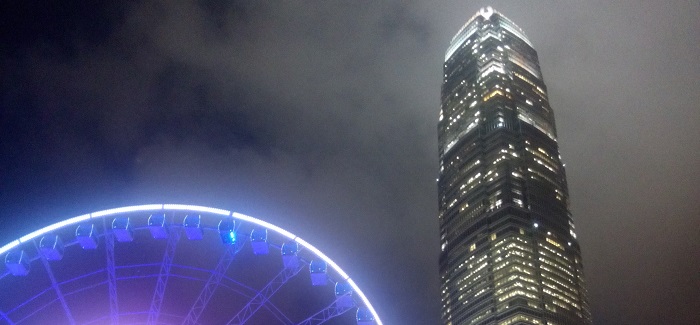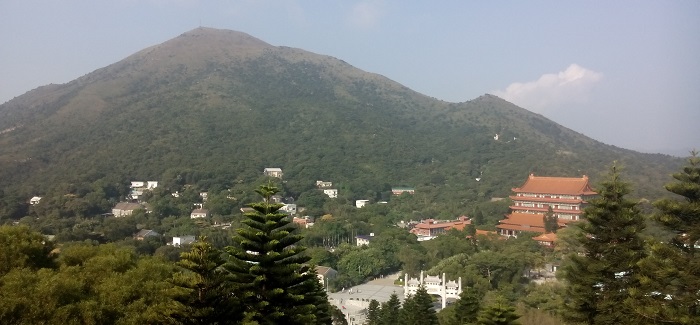|
Without a doubt, my highlight of 2015 was being able to fulfil a long-held wish to visit Hong Kong. While I can't recall exactly when I first became interested in the territory, it was definitely Hong Kong cinema which first caught my attention. By the time I had seen John Woo's action classics like The Killer (1989) and Hard Boiled (1992) as well as the widely-acclaimed thriller Infernal Affairs (2002), I was fast developing a fascination not only with Hong Kong film but also the culture, geography and history of the territory itself. By 2011, I finished my dissertation on the negotiations which led to the 1997 handover and my interest in Hong Kong had grown still further – but the territory still seemed like an incredibly remote and inaccessible place. With the arrival of 2015, two things gave me the resolve to actually plan a trip: one, the knowledge that the exhibition on Bruce Lee at the Hong Kong Heritage Museum would not be open forever; and two, the influence of my friend Stevie, who had become interested in Hong Kong himself. As I've launched a new website with a limited blogging capability, I thought I'd post some of my highlights and photos of our ten-day trip in September 2015. To finally see a place I'd been fascinated by for so long was a huge thrill, and we were delighted by the amount we were able to see and do in the relatively short time we had. For me, just to walk the streets I'd previously seen only in films was almost a greater pleasure than seeing the famous sights, like Victoria Peak or the Star Ferry. Although Hong Kong was a British colony for over 130 years and until recently had the third-largest film industry in the world, I find that British people don't tend to know a huge amount about the territory. I hope this overview of our trip will help to show how dynamic and varied Hong Kong is, and just how much there is to see and do there besides the popular image of endless skyscrapers. While in some ways the trip left us with something of a bittersweet feeling (of which more later), it was an incredible experience and I'd enthusiastically recommend a visit to anyone interested in East Asia. 1) The Avenue of Stars Tsim Sha Tsui, Kowloon (Day 2) Based on the waterfront at Tsim Sha Tsui and featuring incredible views of Hong Kong Island, the Avenue of Stars is Hong Kong's answer to the Hollywood Walk of Fame. Unlike its equivalent in California, the Avenue of Stars features only celebrities involved in the film industry (although as is common in Asia, many Hong Kong actors also work as singers). The Avenue opened in 2004, and its iconic bronze statue of Bruce Lee was placed there in 2005. I was pleased to recognise around 40% of the names set into the floor, including my heroes like John Woo, Jackie Chan, Jet Li, Chow Yun-Fat and Michelle Yeoh. Text on a series of nine red columns explains the history of Hong Kong cinema. Sadly, for a number of reasons local film is in decline but in its heyday Hong Kong produced hundreds of films each year in genres as diverse as martial arts, crime, comedy, horror and drama. Infernal Affairs remains one of the territory's best known and most acclaimed films. Featuring a number of popular stars, it was a huge box-office success and was remade by Martin Scorsese as The Departed (2006). At the entrance to the Avenue is a giant replica of the trophy given to winners at the Hong Kong Film Awards (Infernal Affairs won seven in 2003). 2) Seeing Ringo Lam's Wild City iSQUARE Mall, Tsim Sha Tsui, Kowloon (Day 3) One of our key goals for the trip was to see a local film in a Hong Kong cinema. Luckily, we were able to catch one of the last showings of Wild City at the UA Cinema within the huge iSQUARE mall, just a few minutes' walk from our apartment. The local family sat next to us looked quite bemused to see us there, but it was a unique experience. Wild City marks a return to Hong Kong for veteran local director Ringo Lam, who is best known in the west for making City on Fire (1987), a major influence on Quentin Tarantino's first film Reservoir Dogs (1992). Lam is known for edgy but humane crime and action films which have often met with critical acclaim. We very much enjoyed the slick production of Wild City, which stars Louis Koo and Shawn Yue as two estranged brothers who act to protect a young woman (Tong Liya) threatened by a ruthless gang. Better yet, we were able to stumble upon a couple of the film's locations during our subsequent days travelling around the territory. 3) The Wonders of Hong Kong Public Transport All Over (Days 1-10) Hong Kong is only 430 square miles in size and is extremely densely populated – in fact, the Mong Kok area is the world's most densely populated district. As a result, the territory has long relied on a sophisticated transport system. Today, over 90% of journeys are undertaken on public transport. During our trip we sampled most of the available options: bus, taxi, the MTR underground system, sampan, the Airport Express and the iconic Star Ferry. We didn't quite get around to using the historic trams, however. The public transport system is nothing short of a marvel and should be the envy of almost any major world city. The MTR for example is clean, modern, fast and cheap – it's typically something like four or five times more affordable than the London Underground. The beauty of Hong Kong's small size and efficient transportation means that wherever you are in the territory, no other point is ever more than around two hours away. 4) Hong Kong Convention and Exhibition Centre (Day 5) Wan Chai North, Hong Kong Island Convention centres don't tend to be high on anyone's list of holiday priorities, but the Hong Kong Convention and Exhibition Centre had a major part to play in history. This massive and modern structure was the venue for the ceremony in which British rule over Hong Kong officially ended and the territory became a part of the People's Republic of China. In the building's lobby there are some displays featuring some historic photographs of the ceremony, which took place on the night of June 30th, 1997. The building is a major destination for mainland tourists who gather outside around the large statue of Hong Kong's national flower and the flag of the People's Republic. One highlight for us was to see some of the parts of the building which were used as filming locations for Gen-X Cops (1999) and New Police Story (2004). In the latter film, Jackie Chan memorably battled the villains inside the main lobby and on the building's roof. 5) Victoria Peak (Day 5 + Day 10) Western Hong Kong Island While “the Peak” is not Hong Kong's highest mountain – that is the much higher Tai Mo Shan, in the New Territories – it is by far the most famous. Accessible by the Peak Tram since 1888, Victoria Peak is home to a number of attractions, not least the incredible views of Hong Kong Island, Victoria Harbour, and Kowloon. As planned, we visited the Peak both at night and during the day. At night, the lights of the city are an amazing sight and we enjoyed the slightly giddy atmosphere that tends to spread between people in these kinds of spectacular locations. Surprisingly, a taxi up to the Peak at night was very affordable but when we returned during the day we took the opportunity to experience the Peak Tram. At the top, we spent the afternoon of our penultimate day in Hong Kong at Madame Tussauds, and “met” local stars including Donnie Yen, Louis Koo and Michelle Yeoh. 6) Ten Thousand Buddhas Monastery (Day 7) Sha Tin, New Territories The New Territories make up the large majority of Hong Kong's land area but they are much less well-known to foreigners than Hong Kong Island or Kowloon. More spacious and open than those locations, the area's “New Towns” were built to house the territory's rapidly rising population, notably between the 1950s and 1970s. We were specifically drawn to the area of Sha Tin by two different attractions: the first was the Ten Thousand Buddhas Monastery. One of the most impressive religious structures we visited in Hong Kong, the site is not actually a monastery as no monks reside there. It also does not house ten thousand Buddha statues – in fact there are over 12,000! The walk to the site is an attraction in itself: the views of Sha Tin are impressive and the route is lined with hundreds of different Buddha statues. At the top, numerous buildings make up the complex, which was used in the opening scene of Infernal Affairs in which Eric Tsang's character sends his Triad moles to infiltrate the Hong Kong Police Force. 7) Hong Kong Heritage Museum (Day 7) Sha Tin, New Territories The second thing which attracted us to Sha Tin was the Hong Kong Heritage Museum – specifically, the temporary exhibition on the life and works of Bruce Lee. While the exhibition isn't particularly large, it offers an exhaustive view of Lee's incredibly productive life, from the letters he sent to his wife to a selection of memorabilia from the height of his popularity in the early 1970s. The best aspect of the exhibition is probably the themed areas dedicated to each of his completed films – on display there is film footage, behind the scenes information, and artefacts such as the bladed hand worn by Han (Shih Kien) in Enter the Dragon. Outside the museum there is a statue of Lee which isn't as accurate as the more famous one at the Avenue of Stars, but is still worth a look. Afterwards, we took the chance to wander into Lion Rock Country Park, where a tough walk was rewarded with more great views of Sha Tin. 8) Central by Day and Night (Day 4 + Day 9) Hong Kong Island Hong Kong Island's Central is the very core of Hong Kong and like the Peak, is well worth visiting during the day and at night. We first visited when it was dark, and one of the most impressive sights was the Hong Kong Observation Wheel, which is illuminated at night. During the day, we took advantage of our Lonely Planet guide and followed a walk around some of the key sights of Central. As well as picturesque Chater Gardens and the interior and exterior of the HSBC Building – known for its superb feng shui - one of the most interesting sights was the former Legislative Council Building, which is today used as the site of Hong Kong's Court of Final Appeal. Coincidentally, the installation of the Court into the building took place just one day before we arrived in Hong Kong. It was also used as the setting for the finale of Ringo Lam's Wild City. 9) Aberdeen (Day 8) Western Hong Kong Island One of the many locations in Hong Kong named after a British figure (in this case, George Hamilton-Gordon, 4th Earl of Aberdeen and former British Prime Minister), Aberdeen is a coastal town famous for its fishing industry. One of the main attractions for us, though, was the floating restaurants in the harbour. These were prominently featured in Enter the Dragon, during the scene in which Bruce Lee, John Saxon and Jim Kelly arrive into Hong Kong by boat. Very little else is recognisable from the sequence, as Aberdeen has changed so much since 1973. Aberdeen is so dominated by its harbour that boats are generally the best way to get around. Luckily it doesn't take a lot of Cantonese to negotiate a quick sampan tour around the area, which was well worth the few dollars it cost. 10) Tian Tan Buddha (Day 11) Lantau Island Along with Man Mo Temple and the Ten Thousand Buddha Monastery, the Tian Tan Buddha at the Po Lin Monastery on Lantau Island is one of the most well-known religious sites in Hong Kong. We didn't have a lot of time to explore Lantau on our final day – and sadly missed out on seeing the historic village of Tai O (featured in Donnie Yen's Kung Fu Killer, among other films) – we did get to see the “Big Buddha”. The beautiful, towering statue is impressive enough in itself, but the structure on which it stands also offers excellent views of Po Lin Monastery and the attractive natural environment of Lantau Island, which is quite unspoilt (around 40% of Hong Kong is protected country park). Inside, there are many sacred artefacts and displays. Many visitors use the Ngong Ping 360 cable car to reach the site, but as this was closed during our visit we took a slightly less glamorous bus ride. There isn't another place in the world quite like Hong Kong. A key reason for this is that under the terms of the 1984 Joint Declaration between the UK and China, the territory will only govern itself until July 1 2047. On that date, Hong Kong will become a full part of the People's Republic, and will be run centrally from Beijing – in short, Hong Kong's way of life is on a ticking clock. The political protests which have rocked the territory in recent years are one sign of the anxiety and uncertainty this situation produces. All the while, Hong Kong's distinctive local culture is constantly being influenced from outside: from the West, from China, and elsewhere: you are at least as likely to see Jennifer Lawrence on a Hong Kong billboard as you are to see a local star. One of our aims during our visit was to get as close as we could to the world of our favourite Hong Kong films, and we succeeded in glimpsing locations used in films like New Police Story, Wild City, Infernal Affairs and others. However, the decline in the number of Hong Kong films being made these days mean that Western, Korean and Japanese films are often more prominently advertised and shown. For a long-time fan of Hong Kong's films, film-makers and stars, it's impossible not to feel at least a little sad. With that being said, we were hugely impressed by the friendly and helpful Hong Kongers we met and our trip left us more convinced than ever that the territory's unique culture is worth celebrating and sharing. From pork luncheon rolls to Temple Street Night Market, we were thrilled by almost everything about Hong Kong (although I won't be in a hurry to eat another moon cake). The visit was absolutely worth it and if anything, has renewed my love of all things Hong Kong.
0 Comments
Your comment will be posted after it is approved.
Leave a Reply. |
About
I write about classic science fiction and occasionally fantasy; I sometimes make maps for Doom II; and I'm a contributor to the videogames site Entertainium, where I regularly review new games. Categories
All
|
